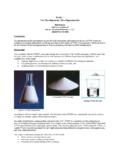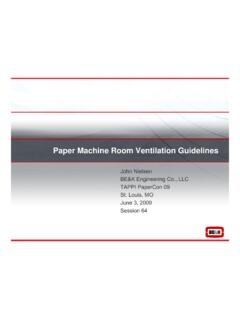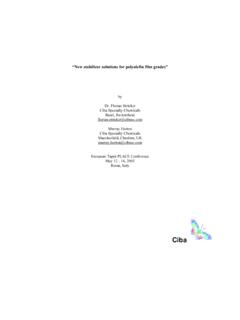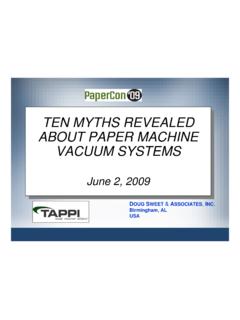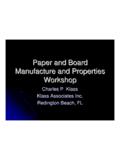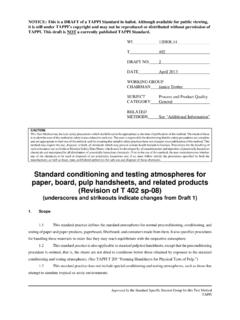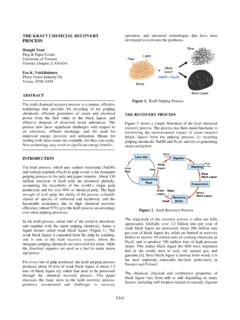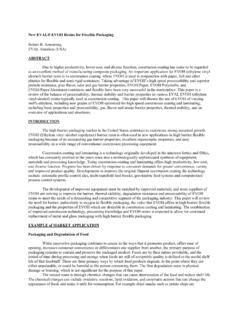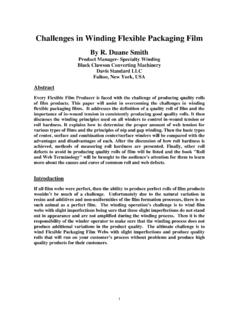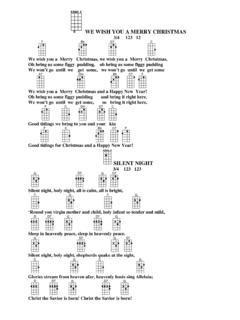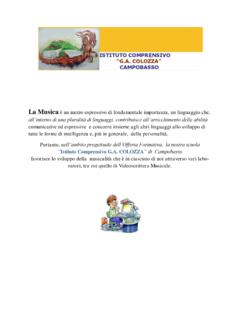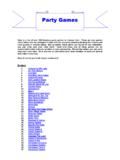Transcription of Recovery Boiler Safety and Audits - tappi.org
1 1 Recovery Boiler Safety and AuditsThomas M. GraceT. M. Grace Company, , Wisconsin Potential Catastrophe A major Recovery Boiler explosion is a catastrophic event at a kraft pulp mill Risk of injury or death Fatalities in 5% of explosions Serious injuries in another 5% Cost of repair Depends on explosion magnitude Lost production2345 Recovery Boiler Explosions0102030405060s70s80s90s00sDeca de# of ExplosionsProgress on Explosion Control Nearly 4 explosions per year in 1960s and 70s Running per year in current decade Only 2 so far this decade in North America Have had several near misses More explosions in other countries6 Types of Explosions Smelt-Water Explosions Due to extremely rapid steam generation Non-combustible in nature Combustible Gas Explosions Accumulation of air-fuel mixture within the explosive concentration range Ignition sourceTypes of Explosions Prevent by keeping smelt & water apart Keep
2 Liquid water out of furnace Make sure smelt is frozen before introducing liquid water to furnace Emergency shutdown procedure Aimed at minimizing likelihood and consequences of an explosionSmelt-Water ExplosionsPressure Part Size Matters Large Magnitude Explosions (13) 11 involved large leaks 2 involved relatively small floor tube leaks Moderate Intensity Explosions (18) 13 involved large leaks (not in floor) 5 floor tube leaks (3 small, 2 larger) Low Intensity Explosions (10) Include 4 from small lower wall leaks Include 2 with cold side ruptures in non-membrane wallsRanking of Failure in Wall, Screen, Tube Leak of Any Leak in Generating Leak in Lower Leaks9No Explosions Have Occurred From Small leaks in wall tubes above lower furnace Small leaks in screen tubes, roof tubes and generating bank tubes Economizer tube leaks of any size The risk of a small leak in wall, screen, roof, or generating bank is thinning an adjacent tube which can then rupturePreventing Explosions from Pressure Part Failures Eliminate tube leaks focusing on the highest risk categories Identify causes of failures Take proactive action Minimize water input to furnace by initiating ESP (emergency shutdown procedure)
3 Rapid drain Boiler Time is critical in a high risk leak10 Time to Initiation of ESP Affects the amount of water into furnace Operators often fail to recognize tube leaks, even large tube leaks This was a factor in 2/3 of explosions involving pressure part failure since 1980 Shortest time lag was 9 minutes In some ESP never initiated This is still a problem Elements of ESP Procedure Alarm and evacuation of danger area Stop allfuel firing Stop air to bed area maintain a balanced draft Drain water out of Boiler (rapid drain) Drain to 8 ft level 15-20 minutes typical drain time Done by a fully automatic system11 Benefits of ESP It works it reduces chance for explosion Less water in better chance to avoid explosion It reduces consequences of an explosion if it should occur Gets rid of the superheated water and steam within the Boiler that would be released if the pressure parts open up When complete.
4 Eliminates major cause of injuries and deathLiquor System Explosions Sources Weak black liquor Wash water Inadvertent dilution Procedures and systems exist that will prevent these events BLRBAC - Safe Firing of Black Liquor These have been very effective last one in 199212 External Sources still a concern Waterwashing furnace after ESP One explosion in 90s Several recent near misses Accelerated bed cooling not a cure-all No positive way to know all molten smelt is absent NCG incineration systems provide another path for water entry Smelt spouts not a likely cause for Boiler explosions unless pressurizedCombustible Gas Explosions Auxiliary Fuel Black Liquor Pyrolysis Gas NCG Incineration13 Auxiliary Fuel Explosions03691260s70s80s90s00sDecade# of ExplosionsSuccessful Prevention of Auxiliary Fuel Explosions Use of Monitored Burners BLRBAC Safe Firing of Auxiliary Fuel 15/16 explosions in 60s & 70s did not have monitored burners in use Exception was not properly maintained 3 of the 4 since 1980 have been on units with monitored burners 2 had unrecognized tube leak in furnace 1 still being installed and adjusted14 Pyrolysis Gas Explosions Source of combustible gas is thermal decomposition of black liquor solids Black liquor accumulation in hot furnace without burning is critical factor Most common scenario is hot restarts without shutting off black liquor Prevention dealt with in BLRBAC Safe Firing of Black Liquor Procedures None in last 15 yearsNCG Incineration No Recovery Boiler explosions involving NCG incineration have occurred (yet)
5 In the USA or Canada BLRBAC has guidelines for waste gas incineration in Recovery boilers This remains a concern because in early stages of gaining experience15 Dissolving Tank Explosions Smelt-water explosions during smelt dissolution Historically have gotten less attention Less costly than Recovery Boiler explosions Reporting has been spotty BLRBAC started list in 1973 after a bad one There are now 27 dissolving tank explosions on the BLRBAC listDissolving Tank ( # per year)16 Causes of Explosions Most (>80%) due to heavy runoff after plugged spouts opened Miscellaneous causes for the other 20%External Resources Black Liquor Recovery Boiler Advisory Committee (BLRBAC) Started in early 1960s Operating mills, Boiler manufacturers, insurers Makes recommendations AF&PA Recovery Boiler Committee Started in mid-1970s Restricted to operating companies Carries out various projects Cooperates with BLRBAC17 BLRBAC Procedures/Guidelines Safe firing of auxiliary fuel Safe firing of black liquor Emergency shutdown procedures Personnel Safety and training Waste streams in Recovery boilers Instrumentation and control system guidelinesHow to Use BLRBAC Attend meetings April & October in Atlanta Go to website Download recommended practices Meeting minutes (available from 2001 now) Summary of incidents reported and discussed Discussions of current issues Report incidents at your mill Comment on proposed changes to guidelines18 AFPA Recovery Boiler Comm.
6 Reference Manuals AFPA Training Program Now available in electronic format Safety Seminars aimed at operators Studies of industry experience Furnace design and explosion damage Floor tube failures Economizers Superheaters (in progress)AFPA RBC Contact Tom Grant Phone (914) 776-6697 E-mail of Recovery Boiler Explosions Management commitment from top down Boiler integrity management program Effective inspection and maintenance program Shutdown planning and follow up Well-trained operators Regular auditsAudits Audits a key element in risk management Need to be done on a regular basis Need to be taken seriously and have management support Need formal documentation and follow up Should involve resources from outside the mill Basically a guided peer review Safety audit should be directed strictly at Safety and reliability Efficiency Audits should be separate from Safety audits20 AFPA RBC Audit GuidelinesFocus Areas Personnel Safety Pressure part integrity Boiler water treatment BLRBAC recommendations Safety interlock systems and fail-safe designs Normal and emergency operating procedures Training Maintenance
7 Operating reliabilityKeys to an effective from top standards for response plan from mill with follow-up procedures Continued carryover of recommendations from year to year is a sign of a flawed process21 Pitfalls Lip service from higher management Lack of belief in the process by operations Adversarial relationships retaliation Lack of standards to audit against Superficiality Lack of a follow-up planThe Audit Song(Santa Claus is Coming to Town)Oh you better clean up, they ll look low and highThe department must look sharp, I m telling you whyThe audit team is coming to town22 Fix the steam leaks,sootblowers better run dry,Mark the escape routes,the paint has to be dry,The audit team is coming to townThey ll find your dirty linen,They ll review each outage tooThey ll look at water and pressure parts, and how well you ve trained your crew23So you better shape up,got to get on the beamOne that younailed last yearis on this years teamThe audit team is coming to tow
